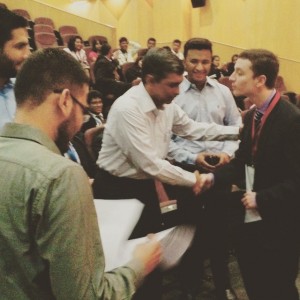Delhi is a dynamic economic hub. It has the highest per capita income in India, and the National Capital Region is the fastest growing region. Yet, last week’s election verdict showed that voters are largely polarized on class-lines. The poor in a substantial measure voted against the traditional parties – BJP, Congress and even BSP – and favored AAP. There are both push and pull factors for this polarization. This indicates disenchantment with major parties’ inability to address the real concerns of the poor. At the same time AAP not only credibly assured liberation from the petty corruption of bureaucracy, but also offered free water and subsidized power.
Clearly, all thinking Indians concerned with wealth creation and economic growth are deeply disturbed about this resounding vote for freebies from India’s richest and most literate sub-region. Post experience shows that short term freebies in the form of consumption subsidies – free power, free water, loan waiver, free rice, cheap kerosene and cooking gas etc – have not improved the lot of the poor. In fact subsidy burden kept on rising even as the poor remained poor. Such heavy consumption subsidies also created distorted incentives, led to leakages and vast corruption, undermined the quality of delivery (power, water, credit, PDS), and diverted the much-needed resources from productive investment and infrastructure. Just as Modi government seems to be keen to promote economic growth and job creation, the poor seem to be favouring short-term consumption subsidies at the cost of growth and jobs. How do we address this challenge honestly and creatively?
All proponents of growth – I am one of those – must realize that growth in itself does not guarantee greater equality. We are a highly fragmented, stratified, caste-ridden, unequal society. Inequality by birth is accepted as a part of natural order, and neither society nor governments exhibited any moral fervour to end this inequality of opportunity. Rapid growth is certainly vital to reduce and even eliminate poverty. But growth in itself does not remove inequalities. In a modern economy, growth certainly makes the poor less poor, and reduces poverty. But growth disproportionately favours those with capital, meaningful education and technology relative to the rest. As a result, even as economy grows and poverty declines, the gulf between the rich and the poor actually widens, creating a more unequal and restless society. This growing inequality obviously undermines social harmony and political stability. In fact, it undermines growth itself as a large proportion of the poor cannot be productive members of society. Jobless growth becomes a characteristic feature of such non-participation of the poor, and we in India have been witnessing it over the past decade. The unrest in society will also lead to breakdown in the consensus on economic growth. Delhi verdict is a clear pointer to all these dangers.
If a creative, genuine political response to this looming crisis is not forthcoming, our politics will be mired in the vicious cycle of class struggle, reckless populism, perpetual fiscal crisis, poor infrastructure, impediments to growth, rising unemployment or underemployment, low productivity, low incomes, more polarization and more freebies. This profound challenge to our economy and society needs to be addressed frontally and honestly if we are to promote growth, jobs, incomes and prosperity.
In the 21st century World, true employment cannot be generated by digging pits and leveling land. We must make our workers productive. The only tool available for the poor to compete with the children of the rich and to give them a fair chance of sharing prosperity is quality education. Tragically, India failed spectacularly in ensuring quality education to the children of poor families. In fact most children – poor or middle class – are denied quality education; and poor quality education perpetuates the vicious cycle of poverty and deepens economic and social inequalities.
The evidence of our educational failure is compelling and conclusive. Among large economies, India has probably the worst record of school education. Our levels of functional literacy (real literacy measured by reading, numeracy, arithmetic and logic) are appalling. In 2009, PISA (an OECD programme) surveyed educational outcomes among 15-year olds among 74 nations/entities. The children’s levels of learning were measured in reading and comprehension, application of math; and logic and science. India ranked 73rd out of 74 nations, with only Kyrgyzstan faring worse than India! China ranked first in this survey. The response of Indian government would be laughable, if it were not tragic. Instead of diagnosing the problem and addressing the challenge earnestly, India chose to drop out of further surveys!
Several surveys, including ASER and government-piloted measurements of learning levels reveal the depressing scenario year after year. About 25% of all children in VIII class in rural areas (those in government or private schools) are not able to read even a simple passage of II Standard difficulty. About 40% of children in VIII class are not able to do a two-digit subtraction (say, 75-46), and about 65% are not able to do a three digit division (say, 365 /7)! This dismal picture obtains in the backdrop of great demand for education from the poorest families. As people increasingly lost faith in the free public education, more and more children are enrolled in private schools. The poorest Indians – vegetable vendors, rickshaw pullers, domestic helpers – are often spending large sums disproportionate to their incomes as private school fees in the hope of giving their children a head start. And yet, our polity’s response is perfunctory, tepid and ineffective.
The much-hyped Right to Education Act (RTE) infused some resources into public education, but the situation in some ways worsened. In the past five years, there is an absolute decline of 10% enrollment in public schools, and a 40% increase in private school enrollment! There is no improvement in outcomes. In fact the RTE had sought to create a license raj in education and further undermined learning outcomes by thoughtless policies. There is now no evaluation or examination of any kind, and children are enrolled in “age-appropriate” classes even if they join school with no literacy!
Happily, the demand side is very strong, and learning levels can be dramatically improved even at the current levels of public expenditure. There is great energy in civil society and tens of thousands of accomplished young Indians and entrepreneurs are willing to pitch in and improve the quality of education. But the law and government policies are a stumbling block. Mere consolidation of schools to ensure scale, institutional environment and better monitoring; a system of sensible, stress-free evaluation at critical stages (say III Std, V Std and VIII Std); innovative infusion of technology and adoption of tried and tested best practices; competition and choice between public schools and accredited private schools in a creative public-private-partnership (PPP) model – these and other interventions will radically alter the situation and give poor children quality education.
Our higher education is equally dismal. Most degrees do not mean much in terms of skills, application of knowledge, capacity to solve real problems, productivity or leadership and team building. Again the demand is very strong. Youngsters at school are labouring very hard for admission into colleges, and parents are willing to spend vast sums in India and abroad to give their children a better chance to pursue higher education or to study abroad. Both public sector and private sector failed in a large measure. Excessive, unwise regulation, staid uniformity, rote-learning, very insipid examination system, complete isolation from industry and society, non-existent research, poor accountability, phenomenal corruption in granting licenses to open professional colleges or for admission in discretionary quota – all these have severely undermined higher education and cruelly exposed our weaknesses in innovation, job creation, problem-solving and productivity. Deregulation, competition and choice, innovative global practices, sensible evaluation, opening up higher education to global universities, exposure to industry and society, technology infusion and focus on R&D will swiftly transform higher education.
With education come the ability to compete, hope and ambition and enhanced productivity and incomes. The great lesson of 20th century is that economic freedom, liberty and competition must be accompanied by quality education for all if we are to reduce inequalities and promote growth, stability and harmony.
If we truly aspire to grow fast and achieve the global status we deserve and desire, we need to radically overhaul our education.
If we continue with the make-believe education for long, social strife, growing inequalities, political upheavals and economic crises will be endemic.
The class polarization witnessed in India’s richest metropolis should be an eye-opener to all.
There is no time to lose.
Jayaprakash Narayan
General Secretary of Foundation for Democratic Reforms
16th February, 2015
Hur väljer de när man väljer balklänningar, vi tar också en titt
Jag vet inte hur många människor tror otaku är intresserade inte förstå, men i själva verket mode cirkel av otaku aldrig varit mycket vänlig. Han gjorde en sak
http://huddunge.se/2012/05/19/anslagstavlan-ar-tillbaka/
http://www.brollopsklanningaronline.com/hur-man-koper-balklanningar-mode-guide.html


